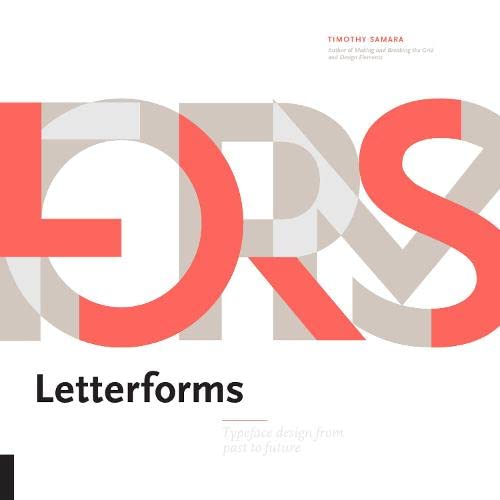Letterforms: Typeface Design from Past to Future

Price: $9.88
(as of Jan 18,2025 23:07:29 UTC – Details)
From the Publisher
Table of contents






Heritage
The trendy alphabet’s standardized shapes and nuanced particulars are the end result of a ten,000-year development from pure picture making for illustration to a notational system of summary symbols, or writing. Its roots lie within the day-to-day recording of market transactions and inventories of grains and livestock; over millenia it has developed into a classy medium whose visible traits, within the stylistic qualities of 1 typeface or one other, seize the loftiest ideas and transmit them from current to future—not solely within the practical sense, however metaphorically coloring them for readers. Crafting an efficient typeface by at the moment’s aesthetic requirements first is dependent upon understanding how these requirements got here to be, and why.
Legacies
Over time, like another self-discipline with a protracted historical past, typeface design has developed a set of conventions. Some of those are associated to how characters—letters, numerals, punctuation, and glyphs—are structured for clear recognition and legibility; others have to do with cultural expectations of what makes a cushty, readable fashion, or how a specific fashion conveys feelings emotions and even seems ‘lovely,’ based mostly on historic context. And, after all, the entire elements of a typeface, from character shapes to particular person parts in every type, have names given to them over the centuries— sort designers are consummate wonks for his or her jargon. Designers who need to stroll the stroll should discuss the discuss (so to communicate) and faculty themselves on the fundamentals of their chosen craft.
Foundations
One may assume that familiarity with the essential requirements and conventions of typeface development can be ample to begin designing a font. What these conventions don’t reveal, nevertheless, are the challenges they impose in attaining them: Designing a font for intensive studying that requires a constant grey texture, by which all of the letters seem to have the identical proportion and strokes of the identical weight, as an illustration, just isn’t an train in measuring. The number of stroke shapes and their particular person sorts of motion, of joints between them, and of the counters that glue all of them collectively, necessitate throwing out the ruler. Ultimately, letterform design is a recreation of optical illusions that compensate for these variations to make sure the notion of consistency—what’s, and what seems to be, are virtually by no means the identical.






Evolution
With a agency grasp of character constructions and the optical elements that inform their creation, the following step is to truly go about designing. But: Where does one start, and what course of ought to one comply with to get from an preliminary thought to a sound, stylistically cohesive finish outcome?
Whether the plan is for an entire textual content or show face, or a finite set of letters as a model wordmark, the very first thing is to get comfy with making letters by hand. Eventual digital manufacturing apart, most sort designers work manually. Hand-drawing concurrently builds guide management and visible sensitivity to type whereas working to obtain the specified objectives beforehand described. Deciding on a specific fashion follows; then a strategy of defining its traits; and, in the end, adjusting them, character by character, till all inside the set seem visually associated.
Reinvention
One of probably the most fascinating elements of letterform design is how robustly versatile it’s—the essential shapes of characters could also be revised and reformed in virtually infinite methods, creating new kinds from inside a strict, and seemingly restricted, variety of variables. This freedon might be attributed to the iconically distinct recognizability of the varied letters’ kinds; if an A seems to be sufficient like an A, for instance, it would learn as such, and it takes plenty of manipulation to render an A unrecognizable. Taking liberties to transcend mere perform and impart that means, or narrative, is prime to creating show faces, titling and, most particularly, model marks, the place conveying concepts past the express is crucial. Designers who perceive historic precedent are, oddly, in a greater place to liberate their investigations from historic fashions and so innovate new kinds with nice integrity, formal sophistication, and resonance.
The state-of-the-art
Since 1990, the variety of obtainable typefaces has elevated greater than tenfold— from maybe 30,00 to almost 500,000, based mostly on some present estimates. Add to that an uncountable variety of letter indicators, wordmarks, and titling remedies, and the magnitude of typographic exploration approaches the astronomical in scope. Assembled listed below are examples of typeface design and lettering just lately produced for all types of software. Whether created for intensive studying in an editorial context or for a single product identify on packaging, every exploits information of the self-discipline’s historical past and respect its precedents—even when the challenge’s or designer’s objective is to combat them and reinvent accepted kinds to create a newly conceptual expertise.
Publisher : Rockport Publishers; Illustrated version (July 3, 2018)
Language : English
Hardcover : 240 pages
ISBN-10 : 1631594737
ISBN-13 : 978-1631594731
Item Weight : 2.65 kilos
Dimensions : 10.25 x 0.75 x 10.25 inches






